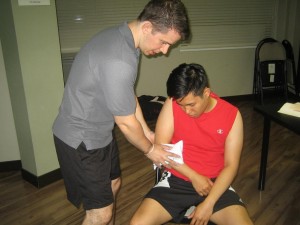A dislocated shoulder occurs when the arm bone pops out of the shoulder socket due to a fall or trauma. This injury is common among those who play football, hockey, rugby, soccer, skiing and other sports.
A severe case of dislocated shoulder where the tissue and nerves found around the shoulder joints are damaged will cause chronic instability and weakness.
[youtube url=”https://www.youtube.com/watch?v=xDePRKeB4kc”]A shoulder separation involves the partial or complete separation of two parts of the shoulder which is the collarbone and the end of shoulder blade or acromion.
Once you suspect that an individual has either a dislocated or separated shoulder, you have to be prepared with the appropriate measures to perform. If you want to be prepared, all you have to do is to register for first aid training today.
Potential causes of separated shoulder or dislocated shoulder
- Being hit in the shoulders
- Falling onto his/her shoulders, usually on a hard surface
- Trying to break a fall using the hand
- Sharp twisting motion of the arms

Sports that can put an individual at high risk for a dislocated or separated shoulder include hockey, rock climbing, soccer, football, skiing, rugby and volleyball.
Symptoms of a dislocated shoulder
- There is pain in the upper arm and shoulder that can cause severe pain when moving the affected area.
- There is a deformity of the shoulder which is a bump found in the front or back of the shoulder, but it will depend on how the bone was dislocated.
Symptoms of a separated shoulder
- There is intense pain immediately after the injury
- There is tenderness of the shoulder and collarbone
- There is evident swelling and bruising
- There is a deformity in the shoulder
Treatment and home remedies
- The individual should rest the affected area and avoid forcing the arm to move.
- Place a pillow or a rolled blanket between the upper arm and chest and wrap a towel around the upper body of the person in order to bind arm to it.
- Apply an ice pack on the shoulder in order to minimize the pain and swelling at least 20-30 minutes every three to four hours for 2-3 days or longer.
- Utilize a sling or a shoulder immobilizer in order to prevent further injury until medical help arrives.
- Provide the individual with anti-inflammatory medications such as ibuprofen or naproxen to help minimize the pain and swelling.
- Encourage the individual to perform mild exercises and strengthening exercises
In case the affected shoulder gets worse, it is best to seek medical attention as soon as possible.
Prevention tips
- The individual should engage in exercises that involve the stretching of the muscles of the shoulder on a regular basis.
- If there is pain during any physical activity, the individual should stop the activity.
- Apply an ice pack over the affected shoulder after any physical activity.
- Always utilize protective padding for protection from falls if there is a risk of shoulder dislocation.
